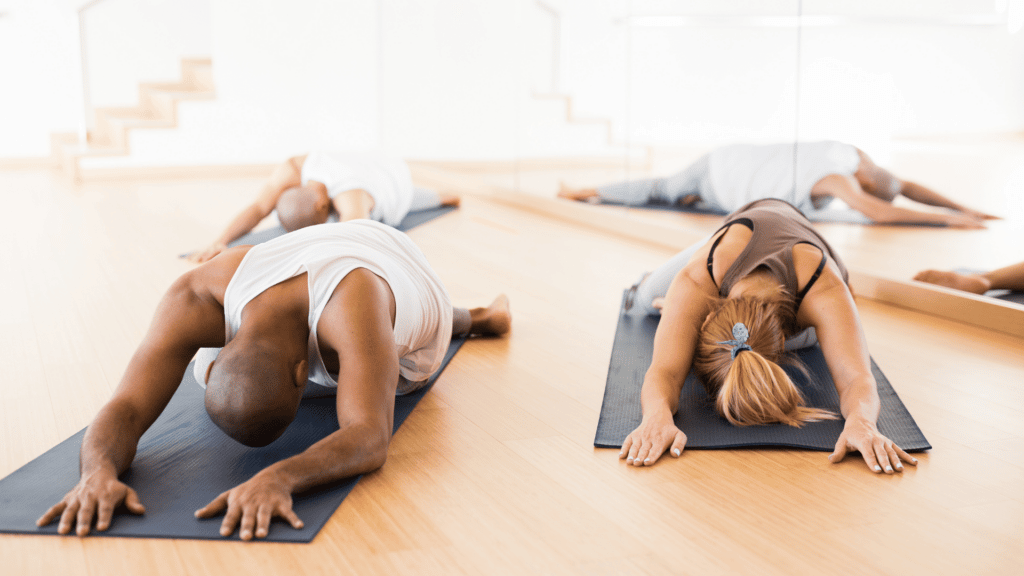Yoga in pairs: poses to practice together - from beginner to advanced

Table of contents
Originally practiced individually, yoga has gained a new version: yoga in pairs. Practicing yoga with a friend, family member, or as a couple can be a source of countless benefits.
For starters, it's a good time to work on trust, deepen the connection, and strengthen the relationship while working towards the same goal. The physique also benefits from the higher intensity in the training. The movements require more elasticity, balance, and strength.
The emotional benefits are also present: besides being a relaxing and relaxed moment, there is the physical touch, which welcomes and relieves anxiety. You see? There are many gains with this practice. So, how about getting to know some yoga poses in pairs? Dig deeper below.
Yoga in pairs for beginners
The practice of yoga requires physical improvement to reach higher levels. When practicing with a partner, this is no different. It is recommended to start with postures that are easier to perform and, thus, evolve together. Check out the main ones:
1 - Balasana - Child posture

JackF from Getty Images / Canva
This is a great posture to start training. It consists of one partner sitting on the floor, with their torso bent over stretched legs, while the other, on top and on their backs, extends their body over his. The idea is that the stretching of both partners is intensified and, thus, there is a complete relaxation, in union.
2 - Navasana - Boat posture

Miriam Alonso from pexels / Canva
The navasana requires more effort in stretching. The partners must bring the soles of their feet together high up, sitting facing each other, while also holding hands. Besides working on balance, this posture stretches the thigh and back muscles more intensely.
3 - Virabhadrasana - Warrior posture

fizkes from Getty Images / Canva
Without physical touch, this posture consists of bending the front leg, leaving the back leg extended; the trunk remains turned forward and the arms are stretched out, while the head is turned to the side. Here, there is a strong stretching of the lower body, as well as some arm work to maintain balance. To work on the connection between the partners, one suggestion is to position yourselvesface to face during practice.
4 - Baddha Konasana - Butterfly posture

koldunov / Freepik
This is a simple posture that can do a lot of work. To do it, just sit with your knees bent and the soles of your feet together. In order to keep your back erect, you should touch your hands to your feet. This position works mainly on the flexibility of the groin area, providing more openness for the hips. When practicing it in pairs, it is also possible to position yourselfof the partners face to face, increasing the connection by looking.
5 - Sitting Twist

SolStock from Getty Images Signature / Canva
Here we have an adaptation of an extremely stretching individual pose. Partners sit back-to-back, each twisting the torso to the opposite side. Leaning your hand back, you can rest it on your partner's leg. This position provides an intense stretching of the spine.
Yoga in pairs for the experienced
For more experienced yogis, it is interesting to expand the possibilities and increase the level of difficulty of the positions. Enjoy some suggestions that we will make below:
1 - Bakasana

Studio Romantic / Shutterstock
This posture requires a lot of arm strength. The practitioner should first squat down, with his hands flat on the ground. Then, slowly, his feet should leave the ground and remain suspended at the elbows. This way, the arms will support all the weight of the body by themselves. Besides them, the wrists are also strengthened with the practice. Performing this posture in pairs helps tomaintain concentration and motivation, in a true test of physical and mental strength.
2 - Urdhva Dhanurasana - The wheel

Degroote.Stock / Freepik
Basically, the practitioners' bodies form a bridge, with the abdomen pointing upwards. The hands and feet must be firm on the ground, while the torso is elevated. The position stretches several muscles, so the arm, forearm, gluteal, tricep and posterior thigh muscles are strengthened. For the practice to be more dynamic and relaxing, it is again suggested that the partners position themselves in athat can look at each other during the execution.
See_also: I Deliver, I Trust, I Accept, and I Appreciate!3 - Uttanasana

fizkes / Shutterstock
Quite easy to perform, the position requires the partners to stand back to back and tilt their torso down. Their bodies will be supported by their glutes, and they must hold each other's arms to hold the pose steady. This is a complete stretch that relieves tension and back pain.
See_also: To Dream of a Dirty Pool4 - Net Posture
More complex to execute, this position requires more experience from the yogis. One of the partners lies down, with legs and arms stretched upwards. The other one lays his trunk on the soles of his partner's feet, while supporting his ankles on his hands. This posture is excellent for relieving back pain and improving posture. It also stretches the pectoral muscles andIt also requires a good deal of trust in your partner.
5 - Bridge Posture

dmitrievproduction / Freepik
Don't be fooled by the apparent ease with which this posture can be executed. It consists of both partners keeping their trunks bent, resting their hands on each other's shoulders, while their legs remain straight and with their feet flat on the ground. The stretching provided is intense and still requires working together to keep the position in balance.
Did you see how yoga can be even more enjoyable when practiced in pairs? Call that loved one and start practicing these positions. You will feel a great physical, mental, and emotional difference over time.

